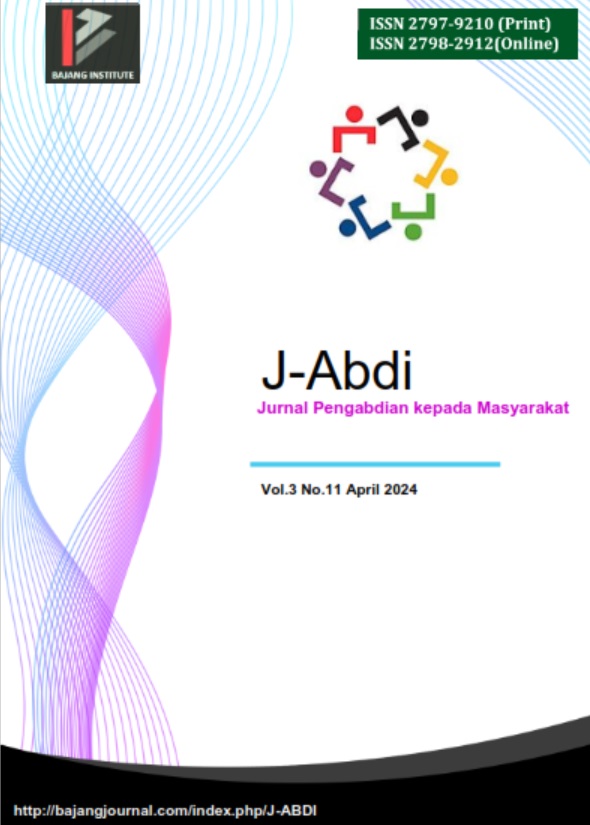DETEKSI DINI GANGGUAN FUNGSI GINJAL PADA PASIEN HIPERTENSI DI WILAYAH KERJA PUSKESMAS BAKUNASE KOTA KUPANG
DOI:
https://doi.org/10.53625/jabdi.v3i11.7630Keywords:
Deteksi Dini, Hipertensi Dan Gangguan Fungsi GinalAbstract
Penurunan fungsi ginjal sangat mempengaruhi kualitas hidup penderita dan meningkatkan beban ekonomi kesehatan karena penatalaksanaan PGK stadium akhir memerlukan pembiayaan yang besar. Sehingga diperlukan upaya pencegahan PGK terutama pada penderita yang berisiko tinggi. Tujuan Pengabdian Masyarakat adalah Meningkatkan Pengetahuan masyarakat tentang deteksi dini gangguan fungsi ginjal. Kegiatan Pengabdian Masyarakat dilakukan melalui 5 tahap yang dimulai dari skrining pasien hipertensi, Pendidikan Kesehatan, konseling, pendampingan kader dan evaluasi Tingkat pengetahuan dan perilaku Masyarakat. Hasil Kegiatan pengabdian masyarakat dengan melakukan edukasi kesehatan dan skrining penyakit gagal ginjal pada pasien hipertensi sebagai salah satu upaya untuk meningkatkan pengetahuan untuk mencegah komplikasi penyakit hipertensi. Pendidikan kesehatan yang diberikan dapat meningkatkan pengetahuan yang dibuktikan dengan nilai rata-rata dari hasil post test adalah 75. Diharapkan kepada keluarga dan masyarakat agar lebih peduli untuk deteksi dini penyakit gagal ginjal pada pasien hipertensi
References
Ammirati, A. L. (2020) ‘Chronic Kidney Disease.’, Revista da Associacao Medica Brasileira (1992). Brazil, 66Suppl 1(Suppl 1), pp. s03–s09. doi: 10.1590/1806-9282.66.S1.3.
Chen, T. K., Knicely, D. H. and Grams, M. E. (2019) ‘Chronic Kidney Disease Diagnosis and Management: A Review.’, JAMA, 322(13), pp. 1294–1304. doi: 10.1001/jama.2019.14745.
Dinkes Kota Kupang, K. (2018) Data Dinas Kesehatan Kota Kupang.
Gounden, V., Bhatt, H. and Jialal, I. (2022) ‘Renal Function Tests.’, in. Treasure Island (FL).
Hannan, M. et al. (2021) ‘Risk Factors for CKD Progression: Overview of Findings from the CRIC Study.’, Clinical journal of the American Society of Nephrology : CJASN, 16(4), pp. 648–659. doi: 10.2215/CJN.07830520.
Hofmeyer, A. and Taylor, R. (2021) ‘Strategies and resources for nurse leaders to use to lead with empathy and prudence so they understand and address sources of anxiety among nurses practising in the era of COVID-19.’, Journal of clinical nursing, 30(1–2), pp. 298–305. doi: 10.1111/jocn.15520.
Kemenkes (2018) Riset Kesehatan. Available at: https://kesmas.kemkes.go.id/assets/upload/dir_519d41d8cd98f00/files/Hasil-riskesdas-2018_1274.pdf.
Levine, G. N. et al. (2017) ‘Meditation and Cardiovascular Risk Reduction: A Scientific Statement From the American Heart Association.’, Journal of the American Heart Association, 6(10). doi: 10.1161/JAHA.117.002218.
Luyckx, V. A. and Chevalier, R. L. (2022) ‘Impact of early life development on later onset chronic kidney disease and hypertension and the role of evolutionary trade-offs.’, Experimental physiology. England, 107(5), pp. 410–414. doi: 10.1113/EP089918.
Polychronopoulou, E., Wuerzner, G. and Burnier, M. (2021) ‘How Do I Manage Hypertension in Patients with Advanced Chronic Kidney Disease Not on Dialysis? Perspectives from Clinical Practice.’, Vascular health and risk management, 17, pp. 1–11. doi: 10.2147/VHRM.S292522.
Price, S. A. dan Wilson, L. M. (2006) ‘Patofisiologi Konsep Proses-Proses Penyakit’, in Edisi IV. IV. Jakarta: EGC.
Pugh, D., Gallacher, P. J. and Dhaun, N. (2019) ‘Management of Hypertension in Chronic Kidney Disease.’, Drugs, 79(4), pp. 365–379. doi: 10.1007/s40265-019-1064-1.
Spence, J. D. (2018) ‘Controlling resistant hypertension.’, Stroke and vascular neurology, 3(2), pp. 69–75. doi: 10.1136/svn-2017-000138.
Suzanne C. O’Connell Smeltzer, Brenda G. Bare, Janice L. Hinkle, K. H. C.- (2004) ‘Brunner & Suddarth’s Textbook of Medical-surgical Nursing’, in. Philadelphia: Lippincott Williams & Wilkins.
Teo, B. W. et al. (2021) ‘Hypertension and chronic kidney disease in Asian populations.’, Journal of clinical hypertension (Greenwich, Conn.), 23(3), pp. 475–480. doi: 10.1111/jch.14188.
Vallianou, N. G. et al. (2019) ‘Chronic Kidney Disease and Cardiovascular Disease: Is there Any Relationship?’, Current cardiology reviews, 15(1), pp. 55–63. doi: 10.2174/1573403X14666180711124825.














